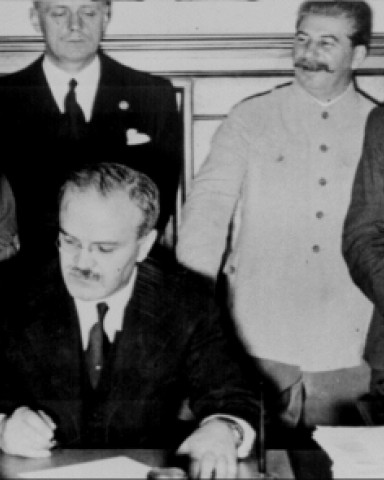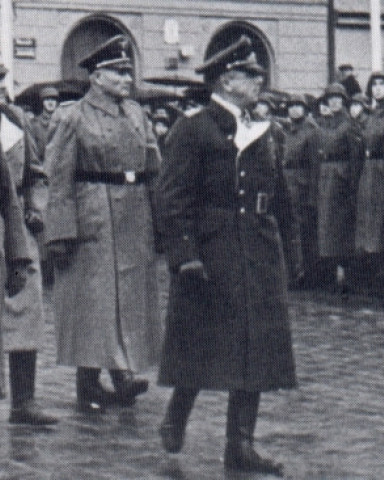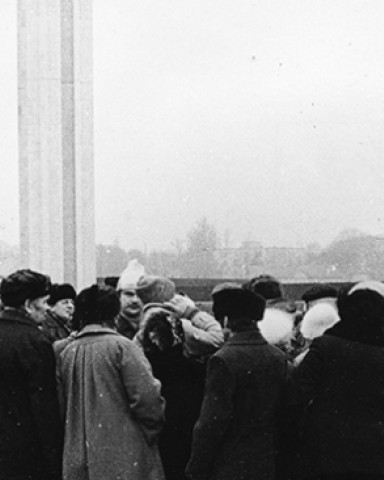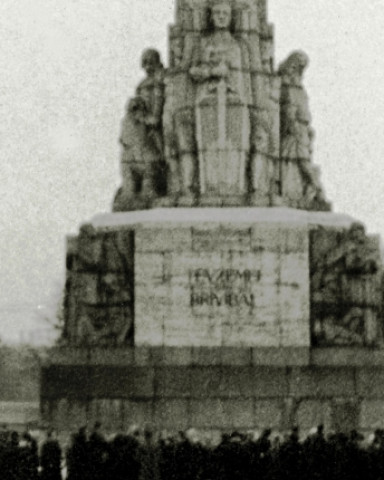-
August 23, 1939
The Soviet Union (USSR) and National Socialist Germany conclude a non-aggression treaty (the Hitler–Stalin Pact). Its secret protocol provides for the division of Poland and the inclusion of Finland, Estonia, Latvia, and Bukovina in the "sphere of interest" of the USSR.
-
September 1, 1939
Germany attacks Poland, the Second World War begins. Declaration on neutrality adopted by Latvia.
-
September 17, 1939
The troops of the USSR invade Poland.
-
September 28, 1939
Germany and the USSR sign a border and friendship treaty, which divides Poland, includes Lithuania in the "sphere of interests" of the USSR and in secret protocols, provides for the exodus of ethnic Germans from the "sphere of interest" of the USSR, and cooperation of the secret services.
-
October 5, 1939
Under military and political pressure, Latvia signs a Mutual Assistance Pact with the USSR, allowing the establishment of bases in western Latvia for 25,000 USSR soldiers of the Red Army and Soviet Navy.
-
October 30, 1939
The Government of Latvia concludes an agreement with National Socialist Germany on the transfer of ethnic German Latvian citizens to Germany.
-
June 12, 1940
The Soviet Navy begins a naval blockade of the Baltic States. At dawn on June 15, Soviet NKVD forces attack three posts of the Eastern Border Guards of Latvia. Buildings are burned, five persons killed, 37 captured and taken to Russia.
-
June 16, 1940
The USSR submits an ultimatum to Latvia, demanding the resignation of the Latvian Cabinet of Ministers and unrestricted admission of USSR troops in Latvia. The Latvian government accepts the ultimatum without protest or resistance.
2nd soviet occupation
-
1939–1940
HITLER–STALIN PACT
-
1940–1941
THE FIRST SOVIET OCCUPATION
-
June 17, 1940
The armed forces of the USSR occupy the entire territory of Latvia.
-
June 20, 1940
The Soviet occupying power in Latvia establishes a new government obedient to Moscow under the leadership of Augusts Kirchenšteins.
-
July 14–15, 1940
In violation of the Constitution of Latvia, illegal elections to the Saeima (Parliament) are held, in which only one list of candidates is allowed to participate – the Communist-controlled Working People's Bloc of Latvia.
-
July 21, 1940
The new Saeima unanimously proclaims Latvia as a "Socialist Soviet" republic and asks it to be admitted to the USSR. Kārlis Ulmanis resigns as head of state; the next day he is deported to the USSR.
-
August 5, 1940
The Supreme Soviet of the USSR annexes occupied Latvia.
-
August 13, 1940
The Politburo of the Central Committee of the All-Union Communist (Bolshevik) Party approves the draft Constitution of the Latvian Soviet Socialist Republic (LSSR).
-
November 26, 1940
In occupied Latvia, the Criminal Code of the Russian SFSR comes into force. Its article 58 refers to Counter-revolutionary crimes and is used for political prosecutions.
-
June 13/14, 1941
Mass deportation of Latvian residents. 15 443 inhabitants of Latvia (including 3741 children less than 16 years old) are deported to distant areas of the USSR. Most of the adult men are arrested and imprisoned in penal camps.
-
-
1941–1944/45
LATVIA IS OCCUPIED BY NAZI GERMANY
-
June 22, 1941
Nazi Germany attacks the Soviet Union. Commencement of war activities on Latvian territory. On July 1, the German army captures Riga; by July 7, it occupies the entire territory of Latvia.
-
July 4, 1941
The Nazis immediately begin campaigns to exterminate Jews, particularly in Riga, Daugavpils, Liepāja, and in many small towns.
-
July 16, 1941
Berlin establishes the Occupied Eastern Lands District (Ostland), in which Latvia is one of four districts.
-
November 30, 1941
The mass extermination of Jews imprisoned in the Riga ghetto begins. In total, more than 70,000 local Jews are killed in the Holocaust in Latvia. Thanks to the support of the local population, at least 577 Latvian Jews are saved.
-
May 9, 1942
The Nazi occupation regime establishes a subordinate Latvian Land Self-Government.
-
February 10, 1943
Adolf Hitler signs the order to create the "Latvian SS Volunteer Legion." The Legion is not a military formation, but the designation for two divisions and other units included in the military wing of the SS that are subordinate to the Supreme Command of the German Army, in which mainly illegally conscripted Latvians served.
-
August 13, 1943
Representatives of four former Latvian political parties establish the Central Council of Latvia (CCL) in Riga. Its aim is to restore the independence of a democratic State of Latvia. Konstantins Čakste is elected chairman of the CCL.
-
November 28, 1943
At the Tehran Conference, the leaders of the USA, Great Britain, and the USSR discuss the post-war order in Europe. Joseph Stalin achieves the right for the USSR to keep the Baltic States under its control.
-
March 17, 1944
The Central Council of Latvia approves a memorandum requesting the restoration of an independent Republic of Latvia. It is signed by 188 politicians and intellectuals.
-
July 18, 1944
The Red Army passes over the Latvian border near Skaune. The second Soviet occupation of Latvia begins.
-
Late July to early August 1944
General Jānis Kurelis and Captain Kristaps Upelnieks establish a separate Latvian military unit under the command of the German army. It cooperates with the CCL and hopes to become the nucleus of a renewed independent Latvian army
-
September 8, 1944
The CCL holds its last meeting in its homeland, where it adopts a declaration on the restoration of the Latvian Republic and the formation of an interim government. The declaration is not publicized, and the provisional government is not formed. Most CCL members flee.
-
November 20, 1944
Realizing Kurelis’ group's intentions, the German Security Service (SD) arrests its leaders. Eight officers are sentenced to death. The rest are sent to the front or imprisoned in concentration camps. The battalion commanded by Lieutenant Roberts Rubenis refuses to surrender and fights several battles against German units.
-
February 5, 1945
In Yalta, the leaders of the USA, USSR, and Great Britain meet. In the negotiations, the Allies accept USSR hegemony in the Baltic States.
-
-
1944/45–1953
SECOND SOVIET OCCUPATION – STALINIST TERROR
-
March 2, 1945
The troops of the USSR Commissariat of Internal Affairs (NKVD) attack the Latvian national partisan camp in the Stompaki swamp in the north-east of Latvia. It is the first and largest national partisan battle against Soviet rule. 28 partisans and 46 Red Army soldiers are killed.
-
May 8, 1945
The Second World War ends on Latvian territory. German troops including Latvian units capitulate in parts of Kurzeme. Some Latvian soldiers join the national partisans.
-
October 6, 1945
Deputies of the Supreme Council of the Latvian SSR approve a decision proposed in Moscow to add the town of Abrene and six surrounding parishes to the Russian SFSR.
-
January 29, 1949
The USSR Council of Ministers issues an order on the deportation of Latvian national partisans, their supporters, and wealthy farmers from occupied Latvia to remote areas of the USSR.
-
March 25, 1949
The occupation regime implements the second mass deportation of the inhabitants of Latvia. 42,125 people – mostly rural people (including 10 987 under the age of 16) – are deported to distant areas of the USSR.
-
July 1949
As a result of the repressive policy of the Soviet occupying power, the collectivization of agriculture accelerates. The number of collective farms in Latvia triples; 3857 collective farms are established.
-
January 4, 1951
The arrests of the so-called "French Group" begin. 13 representatives of Latvian intelligentsia, who met for informal literary evenings to discuss cultural topics with an emphasis on French literature, are arrested and sentenced from 7 to 25 years.
-
March 5, 1953
Death of Joseph Stalin.
-
-
1953–1985
SOVIET OCCUPATION – COLONIZATION OF LATVIA
-
September 12, 1953
Nikita Khrushchev is elected general secretary of the CPSU CK.
-
May 14, 1955
Establishment of the military bloc of European countries controlled by the USSR – the Warsaw Treaty organization.
-
September 17, 1955
The Supreme Soviet of the USSR declares a decree on the amnesty of political prisoners, which allows many deportees to return to Latvia.
-
February 25, 1956
At the XX Congress of the CPSU, Nikita Khrushchev talks about Stalin's crimes and condemns the cult of Stalin's personality.
-
August 23, 1956
A popular uprising begins in Hungary – it is suppressed by the armed forces of the USSR.
-
July 7 – 8, 1959
The Plenum of the Latvian Communist Party Central Committee condemns the activities of National Communists. Repression follows.
-
August 13, 1961
The German Democratic Republic (East Germany) closes its border with West Berlin and begins to build the Berlin Wall.
-
October 10, 1964
Khrushchev is forced to give up the post of General Secretary of the Central Committee of the Communist Party of the Soviet Union (CPSU CK); in his place, Leonid Brezhnev takes over the leadership of the USSR
-
December 1965
The Pļaviņas hydroelectric power plant is opened. The water floods the cultural and historical landscape of the Daugava Valley.
-
May 27, 1968
With the law on the abolition of censorship and amnesty for political prisoners in Czechoslovakia, the "Prague Spring" begins.
-
August 20, 1968
The troops of the USSR and the Warsaw Treaty countries invade Czechoslovakia, interrupting the process of democratization.
-
December 25, 1979
USSR troops invade Afghanistan.
-
September 22, 1980
In Gdansk, Poland, the independent Polish trade union Solidarność is founded, which in the next decade is a key force on Poland's path to democracy and independence from Moscow.
-
November 10, 1982
Death of Leonid Brezhnev. Yuri Andropov becomes general secretary of the CPSU CK. In 1984, he is followed by Konstantin Chernenko; in 1985, on March 11, by Mikhail Gorbachev.
-
-
1985–1991
RESTORATION OF INDEPENDENCE
-
July 25–26, 1985
At the Baltic Tribunal in Copenhagen, Denmark, witnesses provide testimony about Soviet transgressions against the Baltic States.
-
July 26–29, 1985
The Baltic ship of peace and freedom sails from Stockholm past the shores of Latvia and Estonia to the Helsinki Conference on Security and Cooperation in Europe.
-
July 10, 1986
The Latvian human rights advocacy group "Helsinki 86" is established in Liepāja.
-
September 15–19, 1986
The Chautauqua Institute hosts a conference in Jūrmala, where the future U.S. Ambassador to Moscow, Jack Matlock, reports that the U.S. has never recognized Latvia's inclusion in the Soviet Union.
-
October 17, 1986
A critical article in the newspaper Literatūra un māksla (Literature and Art) provokes a widespread public campaign against the construction of a new hydroelectric power plant, which would flood another cultural and historical landscape of the Daugava River.
-
February 28, 1987
The Environmental Protection Club (EPC) is established.
-
June 14, 1987
At the invitation of the Helsinki Group, a protest campaign takes place at the Freedom Monument in Riga, publicly commemorating for the first time the victims of the 1941 deportations.
-
August 23, 1987
Protest at the Freedom Monument on the anniversary of the conclusion of the Hitler–Stalin Pact.
-
April 27, 1988
In Arkady Park in Riga, the EPC organizes a protest against immigration and the planned construction of the Riga metro.
-
June 1-2, 1988
In Arkady Park in Riga, the EPC organizes a protest against immigration and the planned construction of the Riga metro. At the Plenum of the Creative Unions of Latvia, journalist Mavriks Vulfsons declares that Latvia was occupied in 1940.
-
July 10, 1988
The Latvian National Independence Movement (LNIM) is founded.
-
October 8&9, 1988
Founding Congress of the Latvian Popular Front (LPF). Dainis Īvāns is elected chairman of the LPF.
-
January 7, 1989
The Latvian SSR Working People's International Front is established as a counterforce to the LPF. It is popularly called the Interfront, which protests against the state language law and other declared goals of the LPF.
-
February 1989
The Interfront protests against the cessation of immigration and against the granting of the status of the state language to the Latvian language.
-
May 5, 1989
The Supreme Council of the Latvian SSR adopts a language law. Latvian is granted the status of the official language.
-
August 23, 1989
The Baltic Way – a 660 km long human chain through all three Baltic states – protests the consequences of the Hitler–Stalin Pact.
-
November 9, 1989
The Berlin Wall falls
-
November 18, 1989
People's Manifestation "For an Independent Latvia" at the shore of Daugava River in Riga. More than half a million people participate.
-
March 18, 1990
In the elections to the Supreme Council of the Latvian SSR, for the first time there is a choice, and the Latvian Popular Front wins 2/3 of the seats.
-
April 21, 1990
The All-Latvian Assembly of People's Deputies, which is attended by 8086 deputies of all levels, adopts an appeal to the Supreme Council of the Latvian SSR (LSSR SC) to restore the national independence of Latvia.
-
May 4, 1990
The LSSR SC adopts the Declaration on the Intention to Restore the Independence of the Republic of Latvia, recalling also the existence of the State of Latvia as de jure in international law during the occupation and the validity of the 1922 Constitution.
-
October 3, 1990
German reunification.
-
January 2, 1991
The special OMON militia unit of the USSR Internal Affairs troops occupies the Press House in Riga. On January 13, Soviet military forces attack the television tower in Vilnius (Lithuania), kill 14 and injure about 200 people.
-
January 13– 27, 1991
Residents of Latvia participate in the construction of barricades in Riga in order to defend the Latvian authorities against possible attacks by Soviet security forces. In conflicts, five are killed, many are injured.
-
March 3, 1991
In the survey of Latvian residents for a democratic and independent Latvia, almost 3/4 of the population vote for the restoration of the country's independence.
-
June 12, 1991
Boris Yeltsin is elected president of the Russian Federation.
-
August 19, 1991
The radical communist coup attempt in Moscow fails.
-
August 21, 1991
The Supreme Council of the Republic of Latvia adopts the constitutional law: On the Statehood of the Republic of Latvia, declaring the Republic of Latvia an independent, democratic state and that the conditional transition period in the declaration of 4 May has lapsed.
-
After 1991
After the restoration of the actual independence of Latvia, international recognition of this fact and admission of the state to international organizations follows. In September 1991, Latvia joins the Meeting on Security and Cooperation in Europe and the United Nations. In August 1994, troops of the Russian Federation are withdrawn from Latvia.
The strengthening of regained independence is also manifested in domestic politics. In March 1993, the national currency – the lats – is introduced. In July of the same year, the 5th Saeima is elected, and the 1922 Constitution of Latvia enters into full force. In July 1994, the Citizenship Law is adopted, which establishes the procedure for naturalization.
Political distancing from the post-Soviet space becomes irreversible in 2004, when Latvia is admitted to the European Union and NATO. In February 2012, the people of Latvia reject in a referendum a proposal to give official status to the Russian language. Economic integration in Europe reaches a new level in January 2014, when Latvia joins the euro area and puts into circulation the EU's common currency.
-



